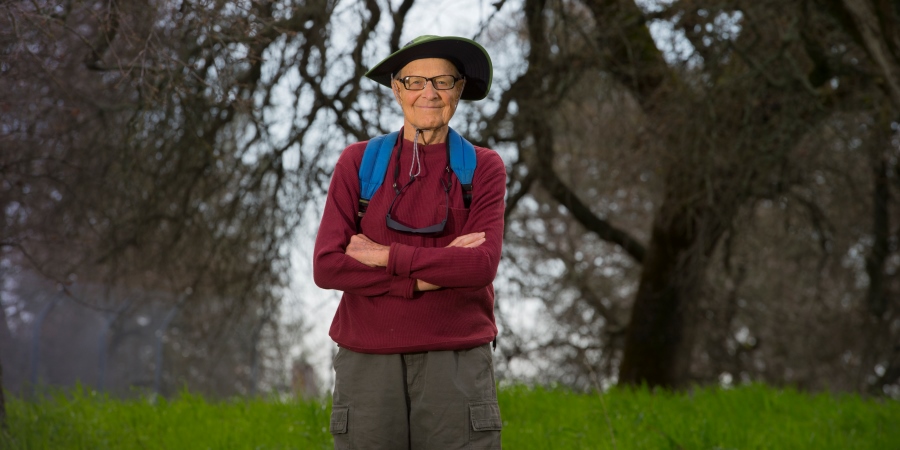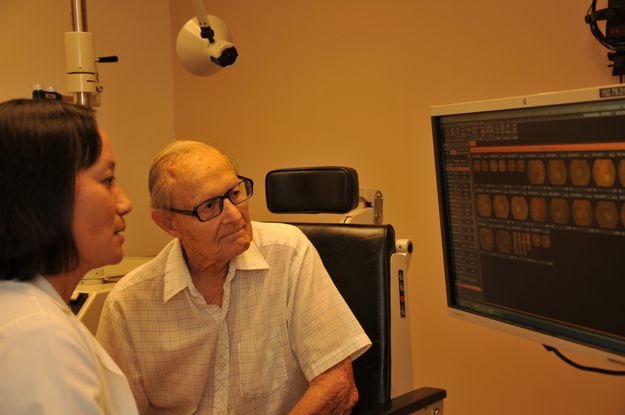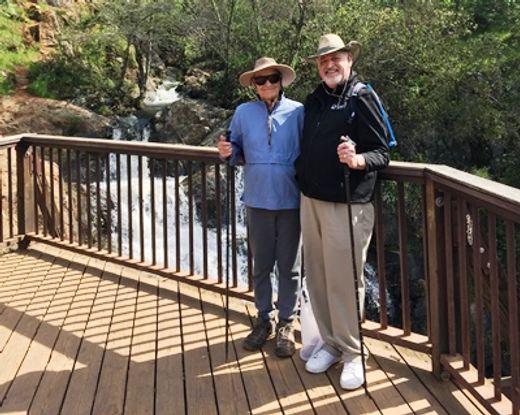
Thanks to glaucoma surgery, 91-year-old Ernest Tschannen can continue to pursue his lifelong love for the outdoors, hiking four miles a day. Photo courtesy of: University of California Regents.
Shunt Surgery Saves Hiker's Vision
Born in Switzerland, retired Sacramento businessman and nature lover Ernest Tschannen has hiked mountains from the Alps to the Sierras. But, when Ernest reached his senior years, he feared his hiking days may soon come to an end. His vision was deteriorating, making reading and driving difficult. When glasses didn’t seem to help, Ernest knew his problem was serious.
Glaucoma: “The Sneak Thief of Sight”
Ernest sought help from an ophthalmologist, a physician who specializes in medical and surgical eye care, who diagnosed him with the eye disease glaucoma. Glaucoma is a chronic eye condition marked by elevated internal eye pressure, called intraocular pressure. Without treatment, it can cause permanent vision loss.
Glaucoma unfortunately has no obvious symptoms in the early stages. Due to this lack of forewarning, many patients like Ernest aren’t diagnosed until their sight has already been compromised. This is why glaucoma is often referred to as the “sneak thief of sight” and why, despite the availability of effective therapies, glaucoma remains a leading cause of blindness. Nearly 3 million people in the United States have glaucoma, but only half of them realize it. In addition, researchers predict that glaucoma will affect as many as 6.3 million Americans by 2050.
Ernest has open-angle glaucoma, the most common form of the disease. It was actually caused by another eye condition Ernest had developed called uveitis. Ernest's ophthalmologist prescribed him medicated eye drops to reduce the inflammation and control his eye pressure to reduce further damage to his vision. The eye drops kept the pressure down for several years, but when Tschannen reached his mid-80s the drops weren’t working. He was referred to glaucoma specialist Michele C. Lim, MD, for further care.
“By the time he saw me there was already extensive damage to his eyes,” said Dr. Lim, vice chair and medical director for the University of California Davis Eye Center.
Shunt Surgery Success
There are several types of treatment for glaucoma, including eye drops, laser surgery and conventional surgery. The type of treatment depends on many factors, such as how advanced the condition is and the type of glaucoma. In Ernest’s case, it was time for surgery.
Dr. Lim surgically placed a device called a tube shunt, also called a glaucoma drainage implant, in his left eye to allow the fluid to drain and decrease the pressure. As he was recovering, the pressure in his right eye started increasing, and three months later she placed a shunt in that eye as well, leading to extraordinary results.
While most people need to continue using eye drops even after tube shunt surgery, Ernest no longer needs them. He controls his eye pressure eye drop-free, which is highly unusual for someone with Ernest's condition.
“Ernest is very fortunate to still have vision considering the extensive damage that had already been done to his eyes,” said Dr. Lim. “I am so pleased that, through the shunt surgeries, we were able to preserve what sight he had left. Given his very active lifestyle, I imagine that total vision loss would have been devastating for him.”
How Vision Loss Could Have Been Avoided

Dr. Lim performed glaucoma shunt surgery on Ernest, saving his deteriorating vision. Photo courtesy of: University of California Regents.
Ernest regrets ignoring the advice he was given to get his eye pressure checked 30 years prior to his initial diagnosis. He figured he was healthy, so he need not worry. Little did he know, he likely already had hidden early signs of glaucoma that only could be detected through a comprehensive eye exam. Early diagnosis and treatment may have prevented his vision from deteriorating to the point where driving and reading became difficult.
The American Academy of Ophthalmology recommends everyone get a complete eye exam performed by an ophthalmologist by age 40.
Various types of exams test eye pressure, but they don’t always detect a problem, Dr. Lim said. That’s because eye pressure can vary. It’s important to have a comprehensive eye exam in which an ophthalmologist looks into the eye to see the optic nerve and performs visual field testing to determine if the patient has lost any vision.
“If I’d have listened, I would have gone to see an ophthalmologist and been diagnosed much earlier, but I was foolish and didn’t do it,” said Ernest.
People at risk of glaucoma should be seen earlier, including those with a family history, who have had a significant eye injury, have diabetes, use ongoing steroids, are African American, Hispanic or Asian or are extremely nearsighted.
Hiking 3-4 Miles a Day with Preserved Vision
Despite losing some of his vision, thanks to the surgery, Ernest has enough sight to return to his active lifestyle. About a month after having his second surgery, Ernest was back on the trails. Today, at age 91, he is defying the odds – doing much more than many people in their 90s, who often struggle to walk or live alone. Ernest is physically fit and lives independently. He hikes three to four miles each day, sometimes taking the steep hill from his Orangevale, Calif., home to nearby Lake Natoma to kayak.
“If I didn’t have the surgery, I would probably be blind,” he said. “I am so grateful that Dr. Lim came to my rescue.”
Every day he is thankful that glaucoma surgery preserved his waning vision so that he can continue to hike, kayak and ride his bike to the store. As someone who has lived his whole life with zeal and relishes every day, Tschannen said losing more vision would have been tragic. In fact, studies have shown how vision loss in seniors can increase risk of falls, depression and even earlier mortality.

Ernest hiking with a friend after successful glaucoma surgery. Photo courtesy of University of California Regents.
Eye exam resources for the public/seniors:
People age 65 or older and concerned about their risk for glaucoma may be eligible for a medical eye exam and up to one year of care at no out-of-pocket cost through EyeCare America. In addition, those who are at an increased risk for glaucoma may also qualify for a glaucoma exam through EyeCare America. This public service program from the Foundation of the American Academy of Ophthalmology matches volunteer ophthalmologists with eligible patients in need across the United States.
Uveitis and glaucoma resources for Ophthalmologists: